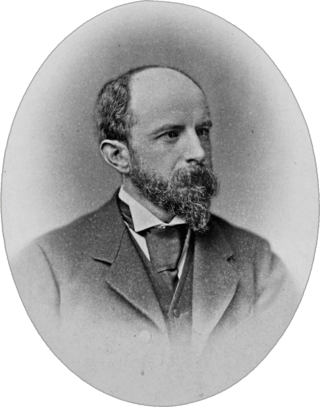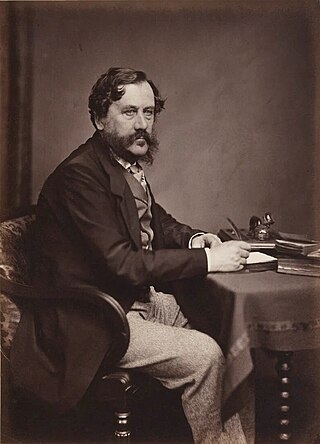Related Research Articles

Abigail Adams was the wife and closest advisor of John Adams, the second president of the United States, and the mother of John Quincy Adams, the sixth president of the United States. She was a founder of the United States, and was both the first second lady and second first lady of the United States, although such titles were not used at the time. She and Barbara Bush are the only two women in American history who were both married to a U.S. president and the mother of a U.S. president.

Henry Brooks Adams was an American historian and a member of the Adams political family, descended from two U.S. presidents. As a young Harvard graduate, he served as secretary to his father, Charles Francis Adams, Abraham Lincoln's ambassador to the United Kingdom. The posting influenced the younger man through the experience of wartime diplomacy, and absorption in English culture, especially the works of John Stuart Mill. After the American Civil War, he became a political journalist who entertained America's foremost intellectuals at his homes in Washington and Boston.

James Howard Harris, 3rd Earl of Malmesbury, GCB, PC, styled Viscount FitzHarris from 1820 to 1841, was a British statesman of the Victorian era.

Mercy Otis Warren was an American activist poet, playwright, and pamphleteer during the American Revolution. During the years before the Revolution, she had published poems and plays that attacked royal authority in Massachusetts and urged colonists to resist British infringements on colonial rights and liberties. She was married to James Warren, who was likewise heavily active in the independence movement.

Charles Francis Adams Sr. was an American historical editor, writer, politician, and diplomat. As United States Minister to the United Kingdom during the American Civil War, Adams was crucial to Union efforts to prevent British recognition of the Confederate States of America and maintain European neutrality to the utmost extent. Adams also featured in national and state politics before and after the Civil War.

Jared Sparks was an American historian, educator, and Unitarian minister. He served as President of Harvard College from 1849 to 1853.

George Spencer, 4th Duke of Marlborough,, styled Marquess of Blandford until 1758, was a British courtier, nobleman, and politician from the Spencer family. He served as Lord Chamberlain between 1762 and 1763 and as Lord Privy Seal between 1763 and 1765. He is the great-great-great grandfather of Sir Winston Churchill.
The Life and Letters of Charles Darwin is a book published in 1887 edited by Francis Darwin about his father Charles Darwin. It contains a selection of 87 letters from the correspondence of Charles Darwin, an autobiographical chapter written by Charles Darwin for his family, and an essay by Thomas Huxley "On the reception of the 'Origin of Species'".
More Letters of Charles Darwin, a sequel to The Life and Letters of Charles Darwin of 1887, was a book in two volumes, published in 1903, edited by Francis Darwin and Albert Seward, containing as the title implies, additional publications of 782 letters from the correspondence of Charles Darwin.

Peacefield, also called Peace field or Old House, is a historic home formerly owned by the Adams family of Quincy, Massachusetts. It was the home of United States Founding Father and U.S. president John Adams and First Lady Abigail Adams, and of U.S. president John Quincy Adams and his First Lady, Louisa Adams. It is now part of the Adams National Historical Park.
Richard Graves (1763–1829) was a Church of Ireland cleric, theological scholar and author of Graves on the Pentateuch. He was a Doctor of Divinity, one of the seven Senior Fellows of Trinity College, Dublin; a member of the Royal Irish Academy; Regius Professor of Greek (Dublin); and Dean of Ardagh. He was the younger brother of Thomas Ryder Graves, Dean of Ardfert and Connor.

Abigail Adams Smith, nicknamed "Nabby", was a daughter of Abigail and John Adams, founding father and second President of the United States, and the older sister of John Quincy Adams, sixth President of the United States. She was named for her mother.

John Adams is a 2008 American television miniseries chronicling U.S. Founding Father and president John Adams's political life and his role in the founding of the United States. The miniseries was directed by Tom Hooper and starred Paul Giamatti in the title role. Kirk Ellis wrote the screenplay based on the 2001 book John Adams by David McCullough.

Thomas Boylston Adams was the third and youngest son of second United States president John Adams and Abigail (Smith) Adams. He worked as a lawyer, a secretary to his brother John Quincy Adams while the latter served as United States ambassador to the Netherlands and Prussia, the business manager of and a contributor to the political and literary journal Port Folio, and a Massachusetts chief justice.
Emma Darwin: A Century of Family Letters 1792-1896 is a book in two volumes, edited by Henrietta Litchfield about her mother, Emma Darwin and letters from their family. It was originally privately published in 1904 as Emma Darwin, Wife of Charles Darwin: A Century of Family Letters, but was publicly published under the shorter title in 1915 by John Murray.
Anna Maria Wells was a 19th-century poet and a writer of children’s literature. The poet and editor Sarah Josepha Hale wrote that Wells, as a child, had a "passionate love of reading and music," and began to write verses when very young. In 1830, Wells published Poems and Juvenile Sketches, a compilation of her early work, after which she contributed occasionally to various periodicals. Hale opined that "the predominant characteristics of [Wells'] poetry were tenderness of feeling, and simplicity and perspicuity of language." Wells' contemporaries, in addition to Sarah Hale, were Caroline Howard Gilman, Hannah Flagg Gould, Eliza Leslie, Catharine Maria Sedgwick, and Lydia Huntley Sigourney

The following is a list and discussion of important scholarly resources relating to John Adams.
The following is a list of works about the spouses of presidents of the United States. While this list is mainly about presidential spouses, administrations with a bachelor or widowed president have a section on the individual that filled the role of First Lady. The list includes books and journal articles written in English after c. 1900 as well as primary sources written by the individual themselves.

Frances Anna Maria Russell, Countess Russell, was the second wife of two-time Prime Minister of the United Kingdom John Russell, 1st Earl Russell. Between 1841 and 1861 she was known as Lady John Russell.
References
- 1 2 "Review of Letters of Mrs. Adams, the Wife of John Adams. With an Introductory Memoir, by Her Grandson". The North American Review. 51 (109): 362–384. 1840. ISSN 0029-2397. JSTOR 25104256.
- ↑ Harbert, Earl N. (1977). The force so much closer home : Henry Adams and the Adams family. New York : New York University Press. pp. 12–17. ISBN 978-0-8147-3375-2.
- 1 2 "Letters of Mrs. Adams, the Wife of John Adams". Christian Examiner and General Review. 29: 245. November 1840.
- 1 2 3 Akers, Charles W. (1980). Abigail Adams, an American woman. Boston : Little, Brown. p. 194. ISBN 978-0-316-02040-4.
- 1 2 "Article VI: The Adams Correspondence". The Christian Review. 6: 557–576. December 1, 1841.
- ↑ Fehrman, Craig (2010-05-21). "First Lady Lit". The New York Times. ISSN 0362-4331 . Retrieved 2021-11-24.